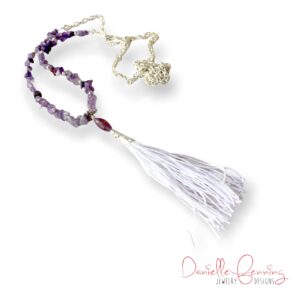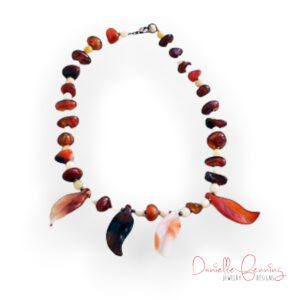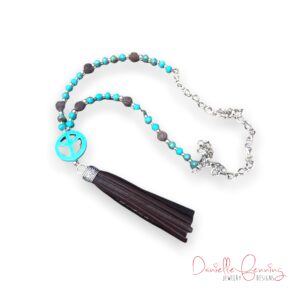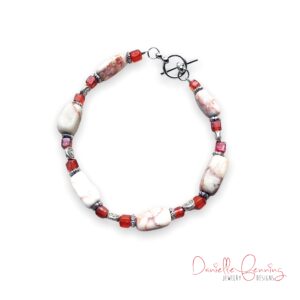Description
The Gold Agate and Pearl Rust Leather Tassel Necklace is made from semiprecious gold quartz rounds, rust colored freshwater pearls and strung with silver tone chain and handmade genuine leather rust brown tassel for the pendant. All metals are nickel and lead free.
Quartz is a mineral that is composed of silicon and oxygen atoms. It is one of the most abundant minerals on Earth and comes in many different forms, such as clear quartz, amethyst, rose quartz, and smoky quartz. It is known for its versatility and durability, as well as its beauty.
Quartz has a long history of use in many ancient cultures. In ancient Egypt, clear quartz was used to make beads and jewelry, and was also used in burials as a symbol of the sun. The ancient Greeks and Romans believed that clear quartz had healing properties and used it to make amulets and talismans. Amethyst, a purple variety of quartz, was also highly valued by the ancient Greeks and Romans, and was believed to have protective powers and to bring good luck.
Quartz is also believed to have spiritual and healing properties. Clear quartz is said to enhance energy and balance, and to help with focus and concentration. Amethyst is said to help with emotional balance and to promote peacefulness and serenity. Rose quartz is believed to help with self-love and to promote healing of the heart. Smoky quartz is said to help with grounding and to protect against negative energy.
Freshwater pearls are pearls that are cultivated in freshwater mussels, rather than in saltwater oysters like traditional pearls. They come in a variety of shapes, sizes, and colors, including white, cream, pink, peach, lavender, and even gray and black. They are typically less expensive than saltwater pearls and are widely available, making them a popular choice for jewelry.
The history of freshwater pearl farming can be traced back to China, where the technique of culturing pearls in freshwater mussels was first developed over 2,000 years ago. The Chinese have been cultivating freshwater pearls for centuries, mainly in the rivers of the country.
In the 19th century, the Japanese began to cultivate freshwater pearls using a different method, known as the “bead nucleation” technique, where a small bead is inserted inside the mussel along with a tissue graft. This method allowed for the production of pearls in a wider range of shapes and sizes.
Freshwater pearls are now also farmed in other parts of the world, such as the United States, France, and Australia. The farming process is more sustainable than saltwater pearl farming and it produces pearls that are less expensive than saltwater pearls.
In terms of its properties, freshwater pearls have a smooth and creamy texture, and they are said to have a soothing and calming effect. They are also said to have a healing effect on the body, particularly on the skin and the respiratory system.






